Japanese-style Mapo Tofu (Mabo Dofu) is incredibly flavorful but much less spicy than the original Sichuan dish. This family-friendly recipe is enjoyable for children as well. It’s a delicious yet simple weeknight meal that’s ready in just 30 minutes! {Vegetarian/vegan substitution included}
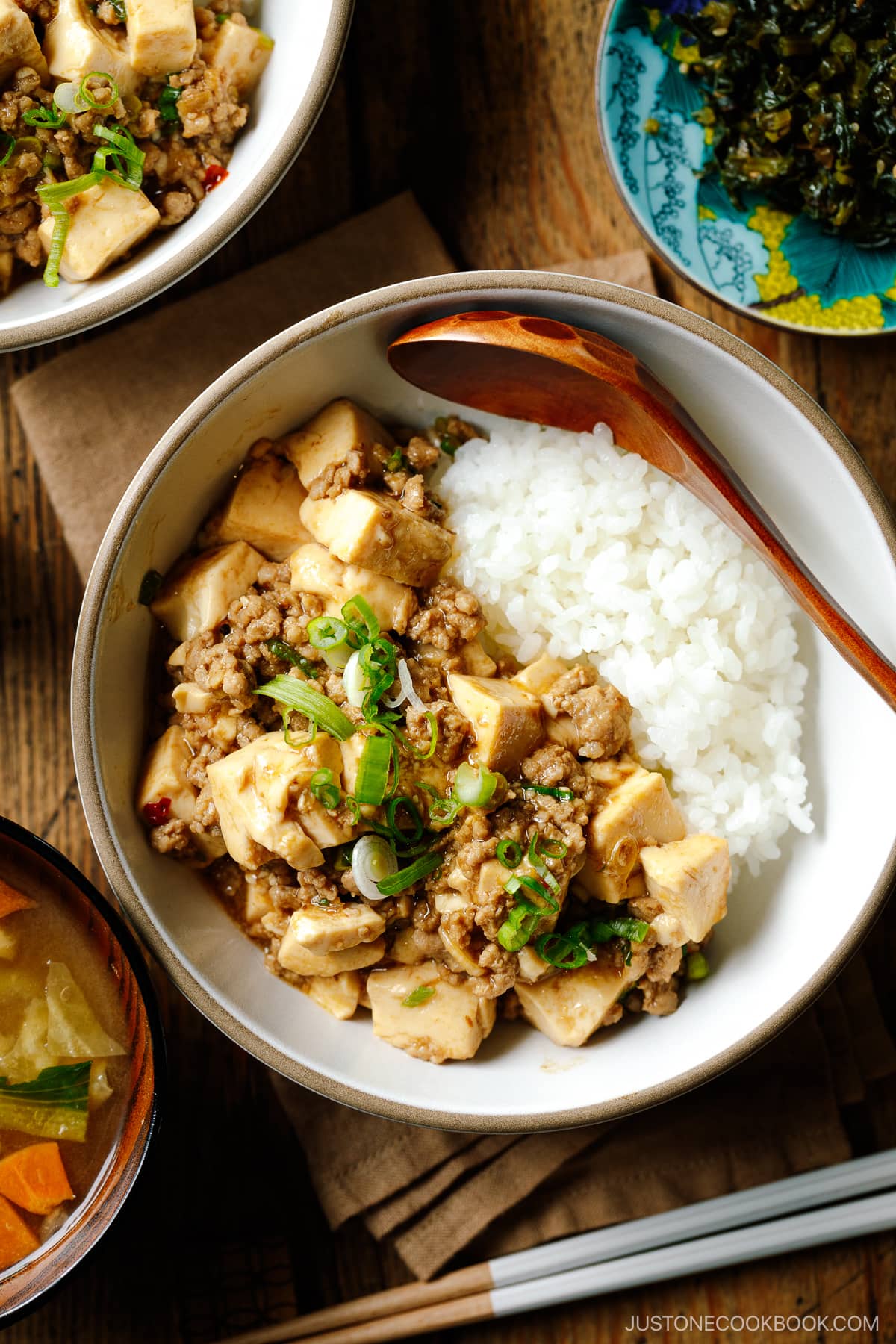
Mapo Tofu (麻婆豆腐) is easily one of our family’s favorite meals! It is so simple to make yet soul-satisfying. I love preparing this dish on a hectic weeknight when I only have 30 minutes to spare for cooking dinner for the family.
We often eat mapo tofu donburi-stylewith the tofu-and-sauce mixture over fluffy steamed rice. Yes, who doesn’t like a one-bowl meal for easy cleanup? I think you and your family are going to enjoy it.
What is Mapo Tofu?
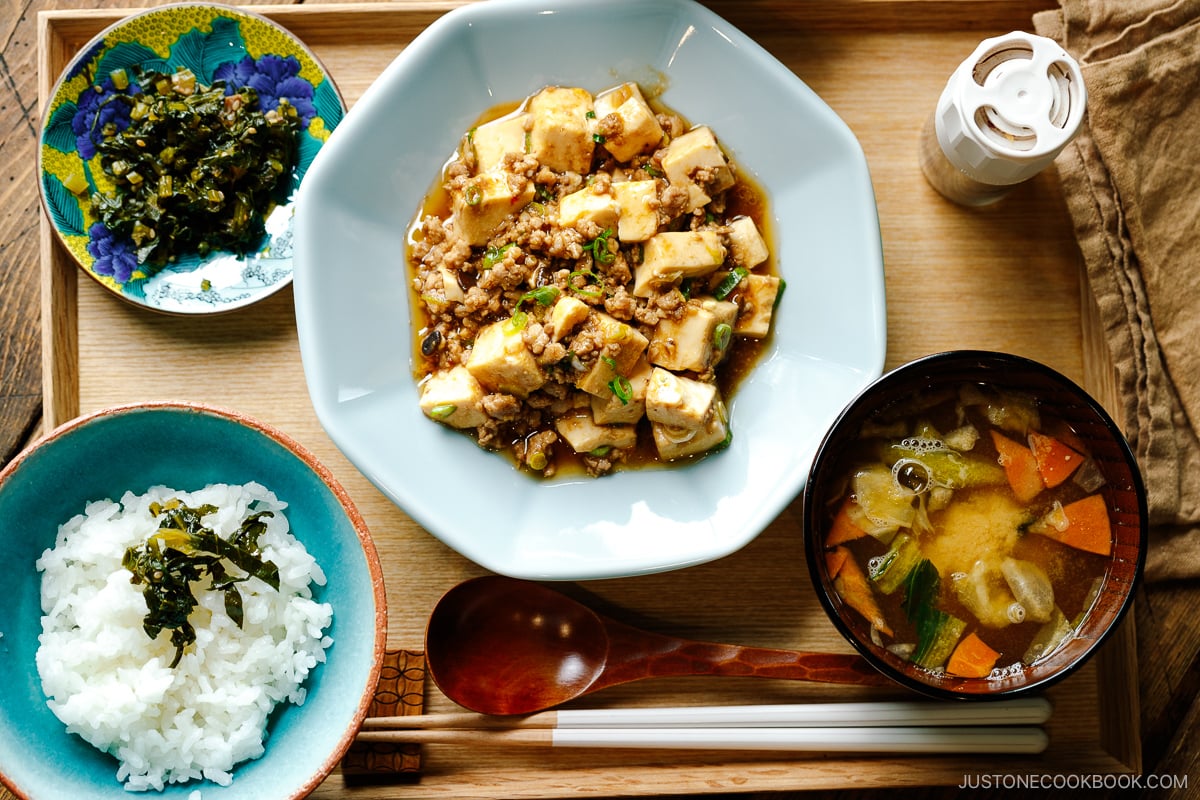
Mapo tofu is a popular Chinese dish from Sichuan province known for its fiery bright red sauce. The classic recipe is made with simmered silken tofu flavored with ground pork or beef, fermented bean paste (douban and douchi), chili oil, and Sichuan peppercorns. The dish is spicy, aromatic, deeply flavorful, and has a unique numbing character imparted from the Sichuan peppercorns.
While the Sichuan-style mapo tofu is known for its boldness and intensity, the Japanese version has a milder character as it has been adapted to the Japanese palate. Nevertheless, Japanese mapo tofu is still packed with lots of umami— thanks to the layering of flavors. Also, the spice level is tamed. If you’re looking for a not-spicy mapo tofu, this recipe is for you!
I’d say Japanese mapo tofu is ideal for anyone who is spice adverse, and even your kids will devour it.
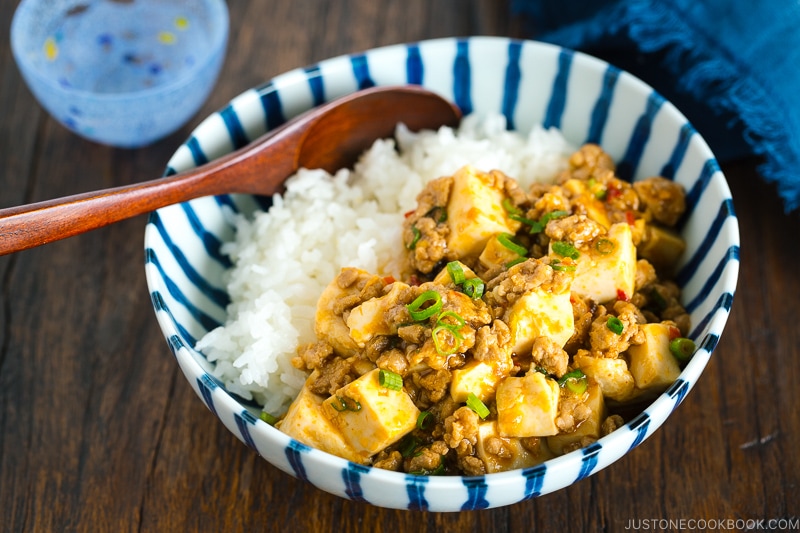
Introduction of Mapo Tofu to Japan
In Japan, mapo tofu is called mabo dofuand it’s written either as mapo tofu or mapo tofu in Japanese.
How did the dish arrive in Japan, you might wonder? It was introduced to the country in the 1970s by Chen Kenmin, a famous Chinese chef in Japan. I mentioned Chef Chen in my previous post here. He was the culinary hero that brought many popular Chinese dishes to the Chinese restaurants in Japan.
Thanks to Chef Chen, you’ll find a number of famous Chinese dishes such as mapo tofu, ebi chili (chili prawns), and beef and bell pepper stir-fry (chin-jao ro-su shredded pork with green pepper) that are now part of our repertoire.
These dishes have been enjoyed in Japanese households for almost half a century! In grocery stores, you can find a whole array of convenient ready-to-eat sauces for these popular dishes. I remember seeing these packages in my mom’s kitchen pantry too.
Difference between Chinese and Japanese Mapo Tofu
There are many versions of mabo dofu within Japan, and each household cooks it differently.
So, what ingredients do the Japanese use in the dish that are not included in the original Chinese mapo tofu? Typically, we would include miso, mirin or sugar, sesame oil, oyster sauce, and occasionally sake.
Most distinctly, Japanese mabo dofu doesn’t include any chili or Sichuan peppercorn.
Most distinctly, Japanese mabo dofu doesn’t include any chili or Sichuan peppercorn. The only “spicy” element comes from doubanjiang, spicy bean paste. However, if you can find a Taiwanese brand of doubanjiang, you can buy a non-spicy doubanjiang (豆瓣酱) or spicy doubanjiang (辣豆瓣酱) with red chili in it. More about it in the next section.
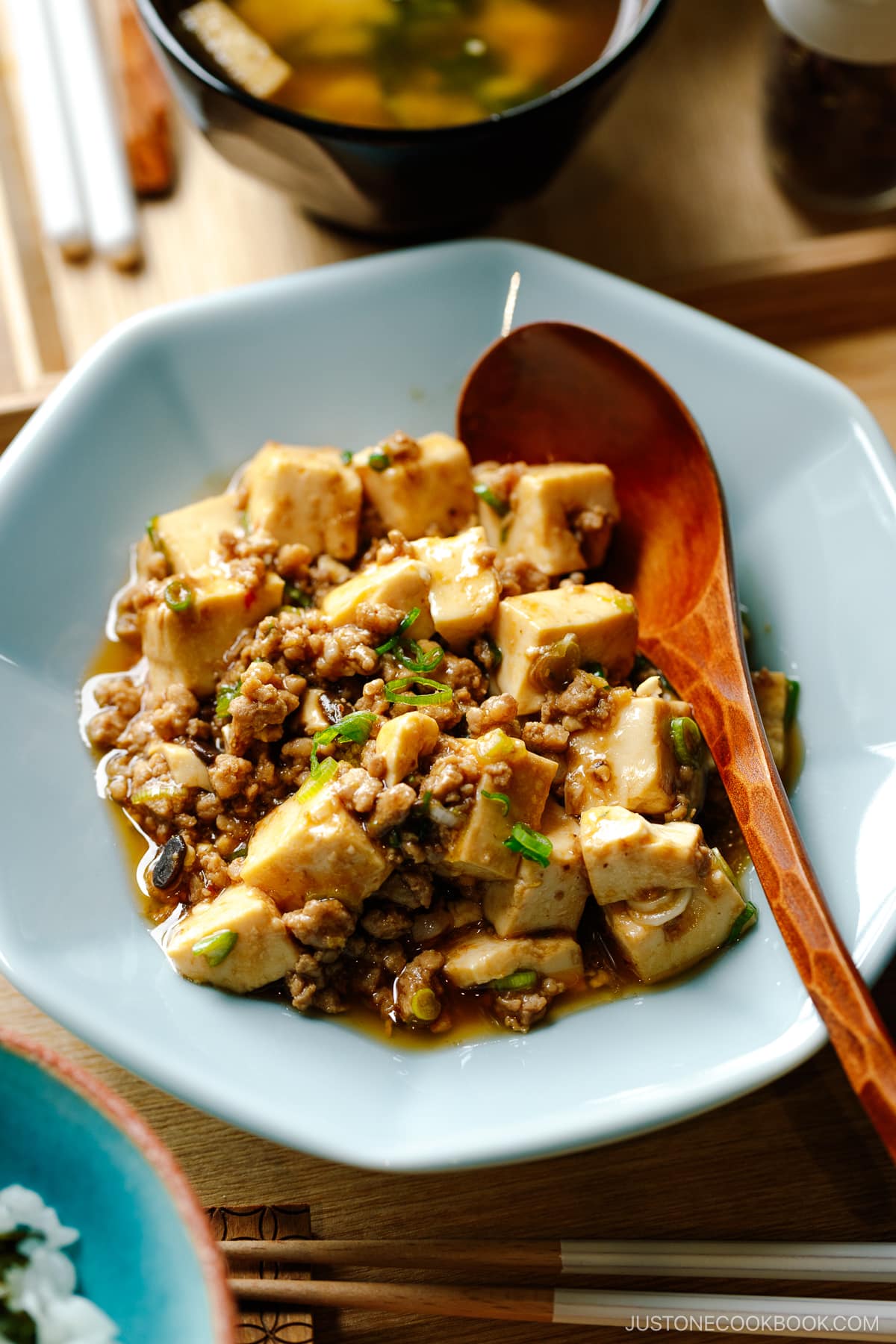
The Ingredients You’ll Need
Here’s what you’ll need for this recipe:
- Ground pork – In Japan, we always use ground pork. However, you can use ground turkey, chicken, or beef.
- Soft/silken tofu
- Aromatics: Green onions, ginger, and garlic
- Condiments: Doubanjiang (spicy/non-spicy broad bean), miso, mirin, oyster sauce, soy sauce, sesame oil, and potato starch (cornstarch)
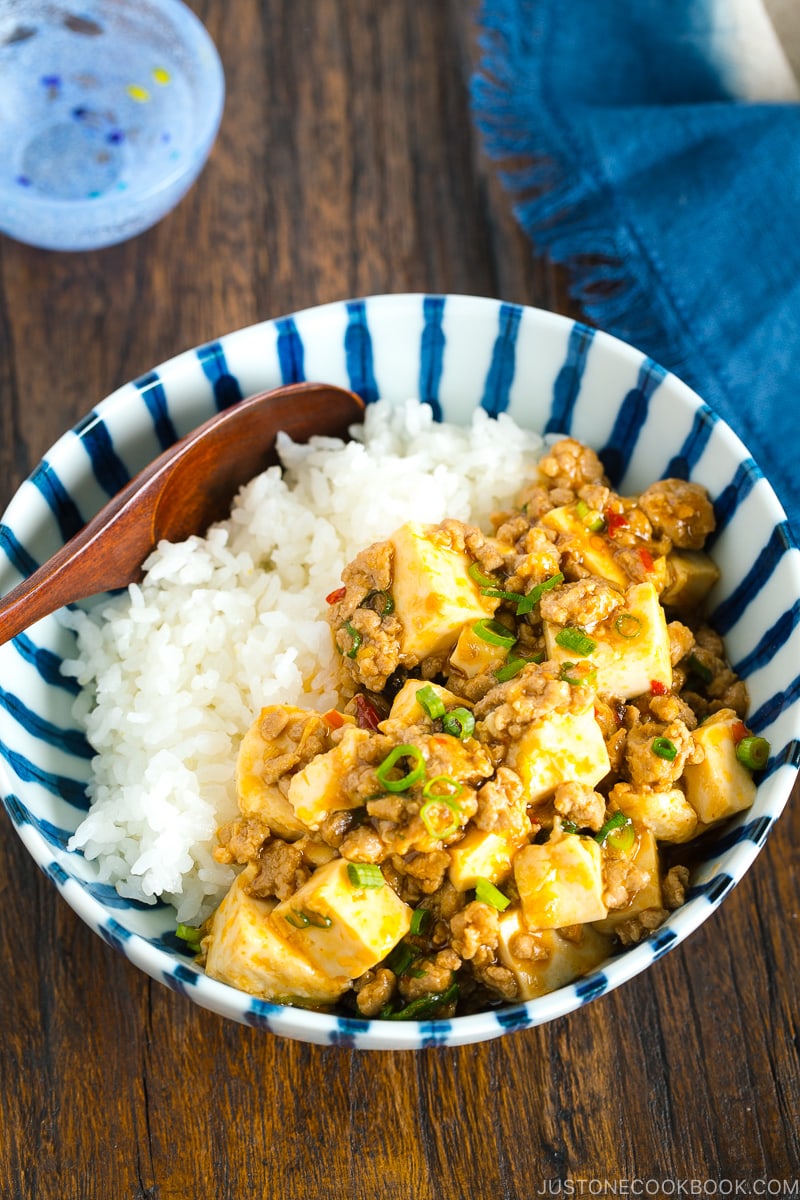
The Key Ingredient is Doubanjiang
This is truly a simple dish to make. The only caveat is you do need to have chili bean paste called doubanjiang (Doubanjiang).
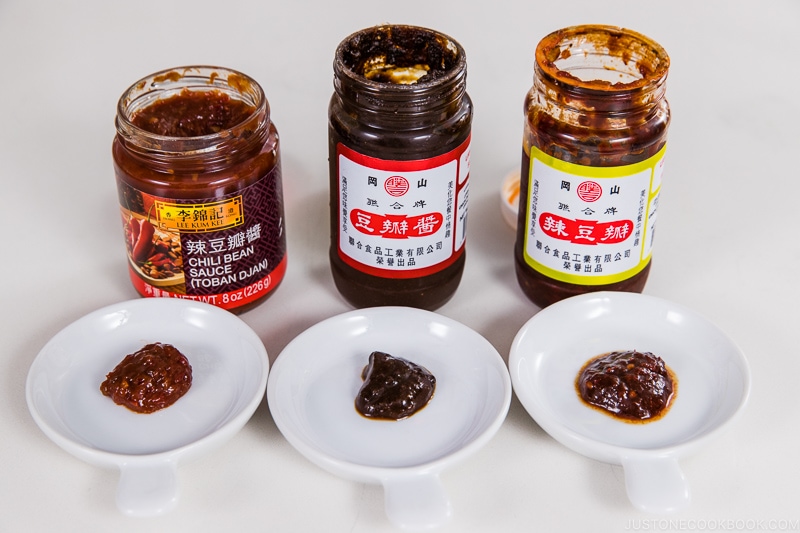
Doubanjiang is a combination of fermented broad beans as the main ingredient, soybeans, and often hot chilies. The salty, savory, umami-rich paste adds an incredible depth and character to mapo tofu that you should not substitute.
Non-Spicy Doubanjiang: Did you know that there is NON-SPICY doubanjiang? Taiwan, Hong Kong, and Guandong in China have non-spicy doubanjiang. It has the same savory depth in the paste but without the heat. To distinguish the two versions, the Sichuan doubanjiang is called la-doubanjiang (Spicy bean paste, “la” meaning ‘hot’ or ‘spicy’).
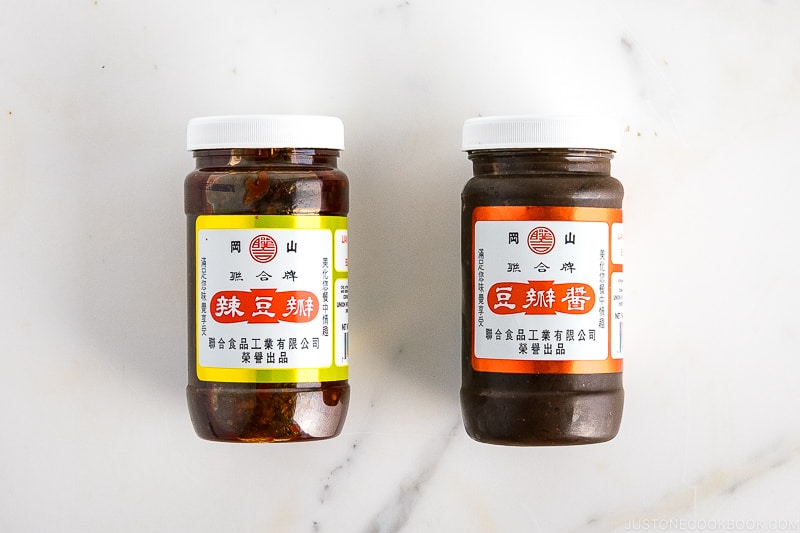
When the kids were small, I used only non-spicy doubanjiang to make my mapo tofu. Taiwanese brands like Kangshan (Okayama) (above) and Ming Teh (明德) offer the doubanjiang made from fermented broad beans and soybeans, as well as the spicy version with chili.
You can get these Taiwanese brands at a local Asian grocery store (I get mine at Marina Market in San Mateo). Amazon does not sell the non-spicy doubanjiang at this time (please let me know if you find one).
Doubanjiang Substitute: If you really can’t find doubanjiang, you can use gochujang (Korean chili paste; spicy) or doenjang (Korean soybean paste; non-spicy). However, the ingredients are slightly different and have different flavor profiles.
The Best Tofu for Mapo Tofu Recipe
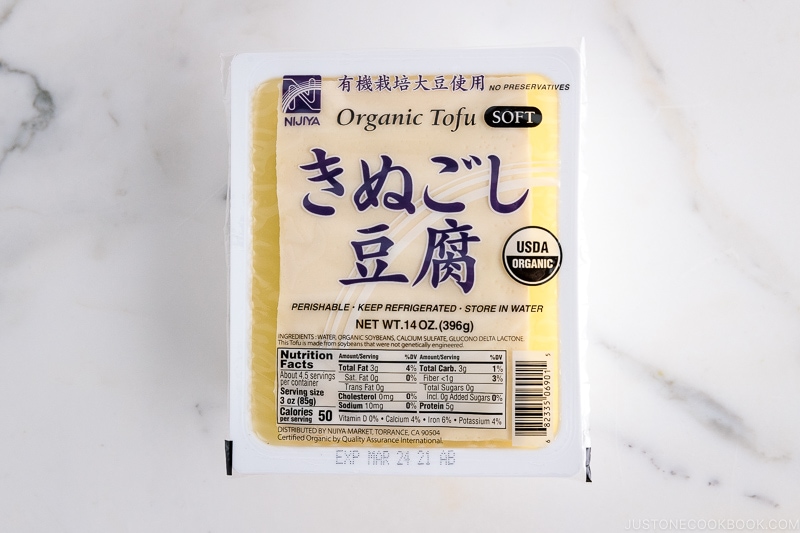
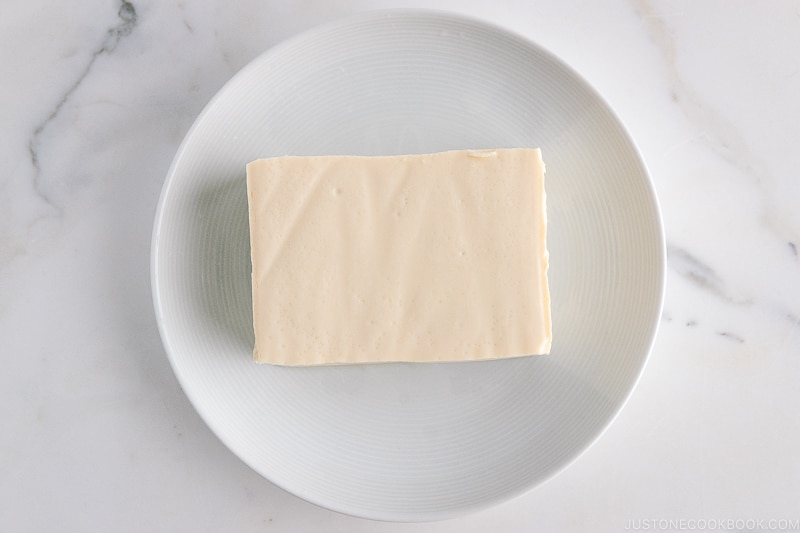
There are many different types of tofu available, but I recommend using soft tofu for the best texture. Soft tofu is smooth, soft, and creamy, which pairs beautifully with the savory sauce and ground meat. It works best for both Japanese-style mabo dofu and authentic Sichuan mapo tofu.
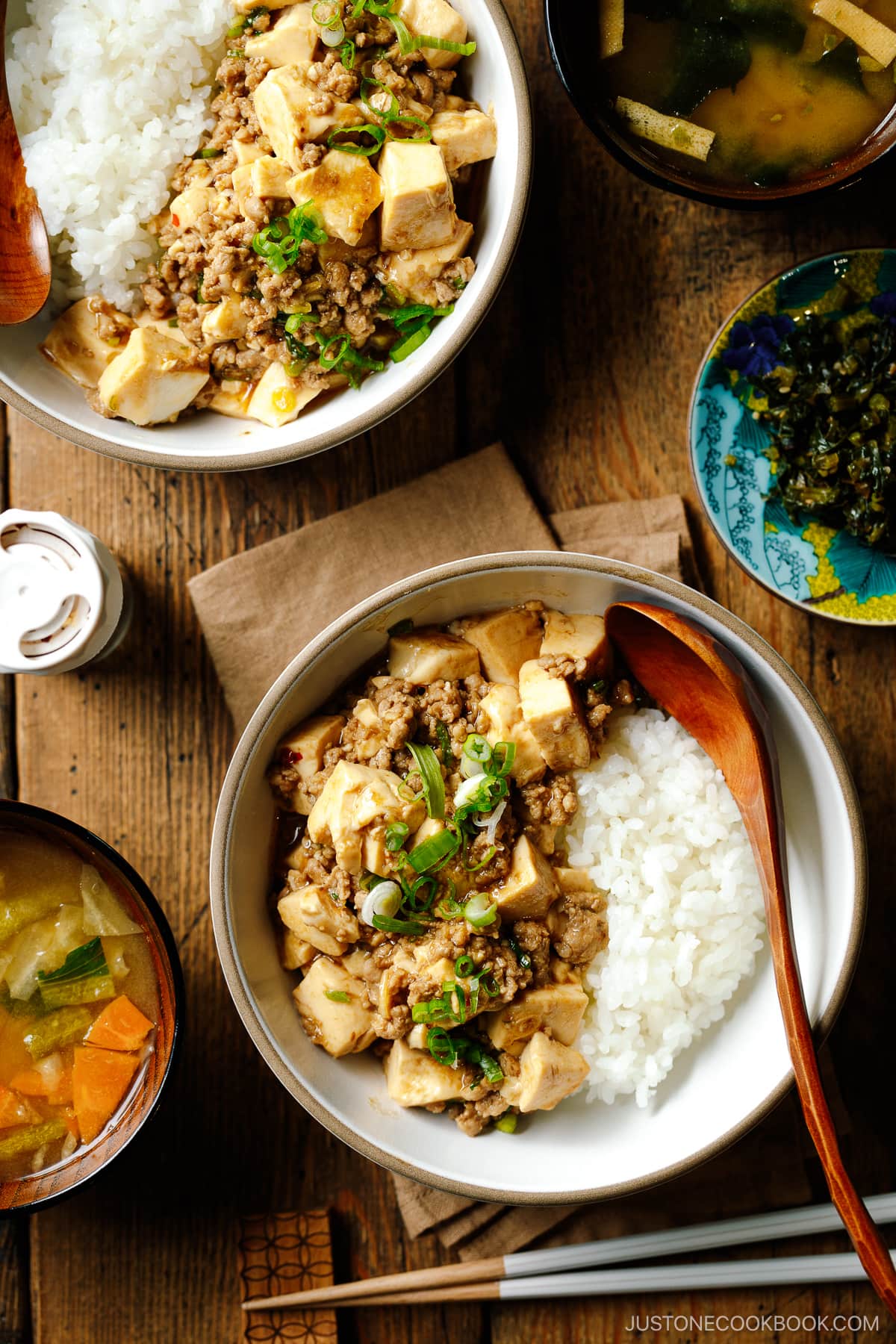
How to Make Mapo Tofu
Mapo tofu is a very easy dish, and my son can make it by himself. This was one of the first few recipes he learned to cook over the summer break one year. He loved this dish so much and wanted to be able to cook it on his own.
Here’s the overview.
- Prepare all the ingredients. Measure and combine all the seasonings before you start cooking.
- Cook the aromatics and ground pork in a frying pan or wok.
- Add the sauce ingredients and let it simmer until the sauce starts bubbling.
- Add the tofu and coat it with the sauce until the flavors infuse.
- Serve on its own or with steamed rice!
Now you have one reliably satisfying dish for the family. I hope you enjoy my Japanese Mapo Tofu recipe!
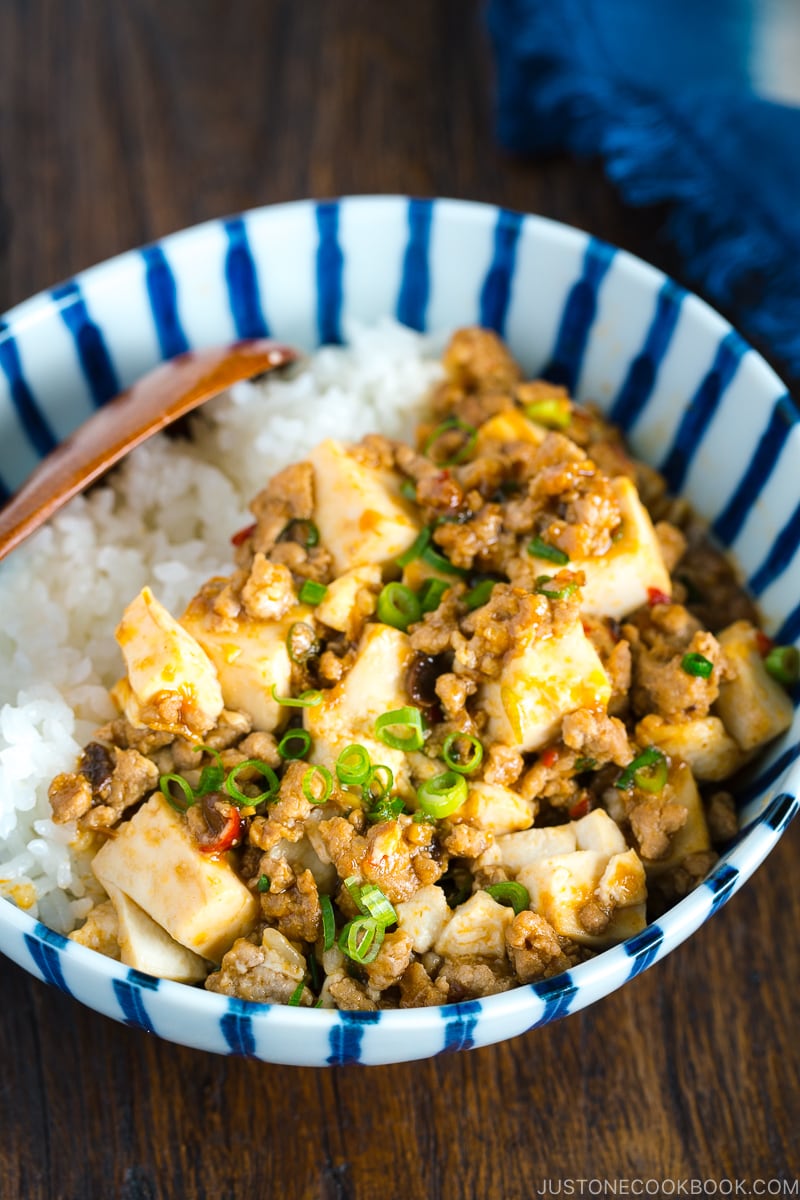
5 Cooking Tips on Making Mapo Tofu
- Measure and cut all the ingredients before cooking.
- Combine all the seasoning ingredients in a small bowl.
- Drain the tofu ahead of time for about 15 minutes. This prevents the tofu from releasing moisture into the sauce.
- Be cautious not to burn the garlic and ginger when stir-frying. You don’t want to add a burnt bitter taste to the sauce.
- Carefully stir the tofu: Tofu can easily break and become mushy. Shake the pan to coat the tofu with the sauce, minimizing spatula action.
The Wok I’m Using in This Recipe
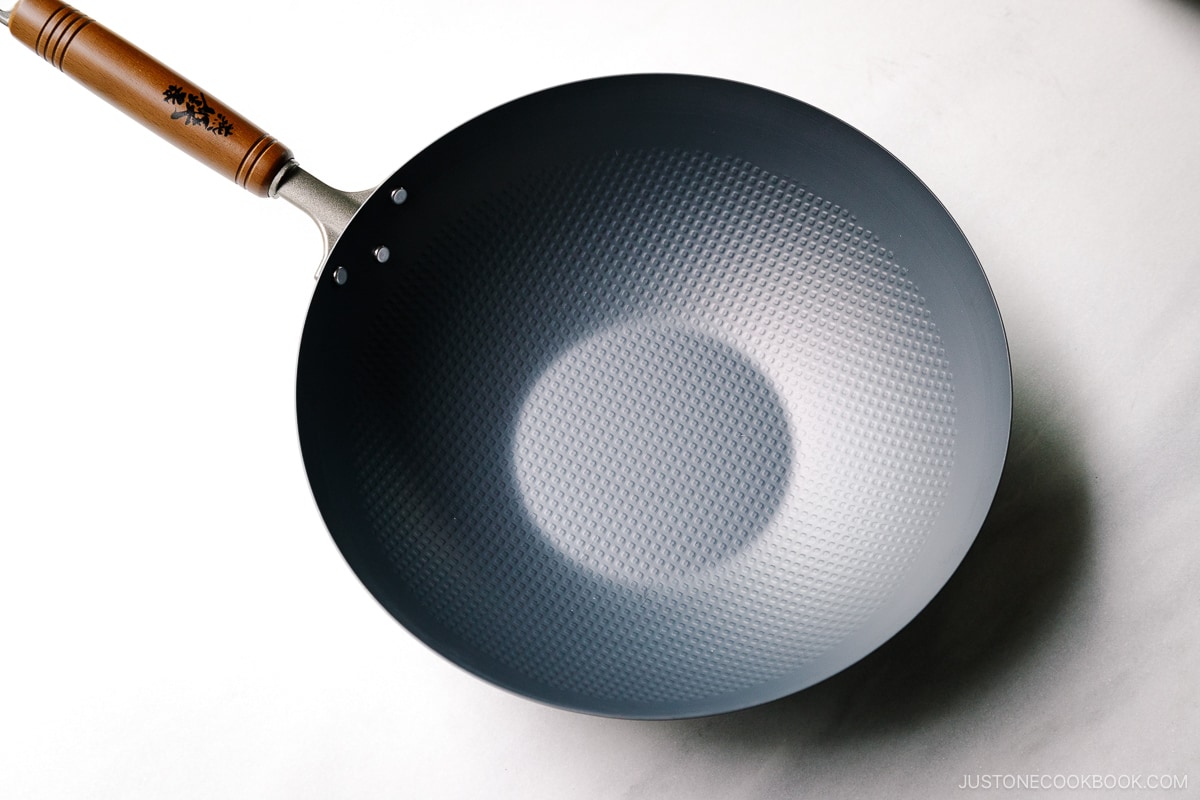
I’m partnering with MTC Kitchenmy favorite Japanese kitchen store in NYC, to try out this carbon steel wok, and I love it!
These nitrogen-hardened wok, a new series of iron cookware from Summit Japan, is infused with nitrogen, offering durability, rust resistance, and all the benefits of traditional carbon steel cookware. They are compatible with induction, gas, or electric stoves. Compared to standard carbon steel cookware, these are extremely durable and rust-proof due to the nitrogen treatment.
I really like Summit’s carbon steel series because they’re much lighter than French carbon steel pans. Their excellent heat conductivity makes them perfect for frying, stir-frying, and grilling—essential for Asian cooking! If you’re looking to invest in a carbon steel wok, I highly recommend them as they will last for years with proper care.
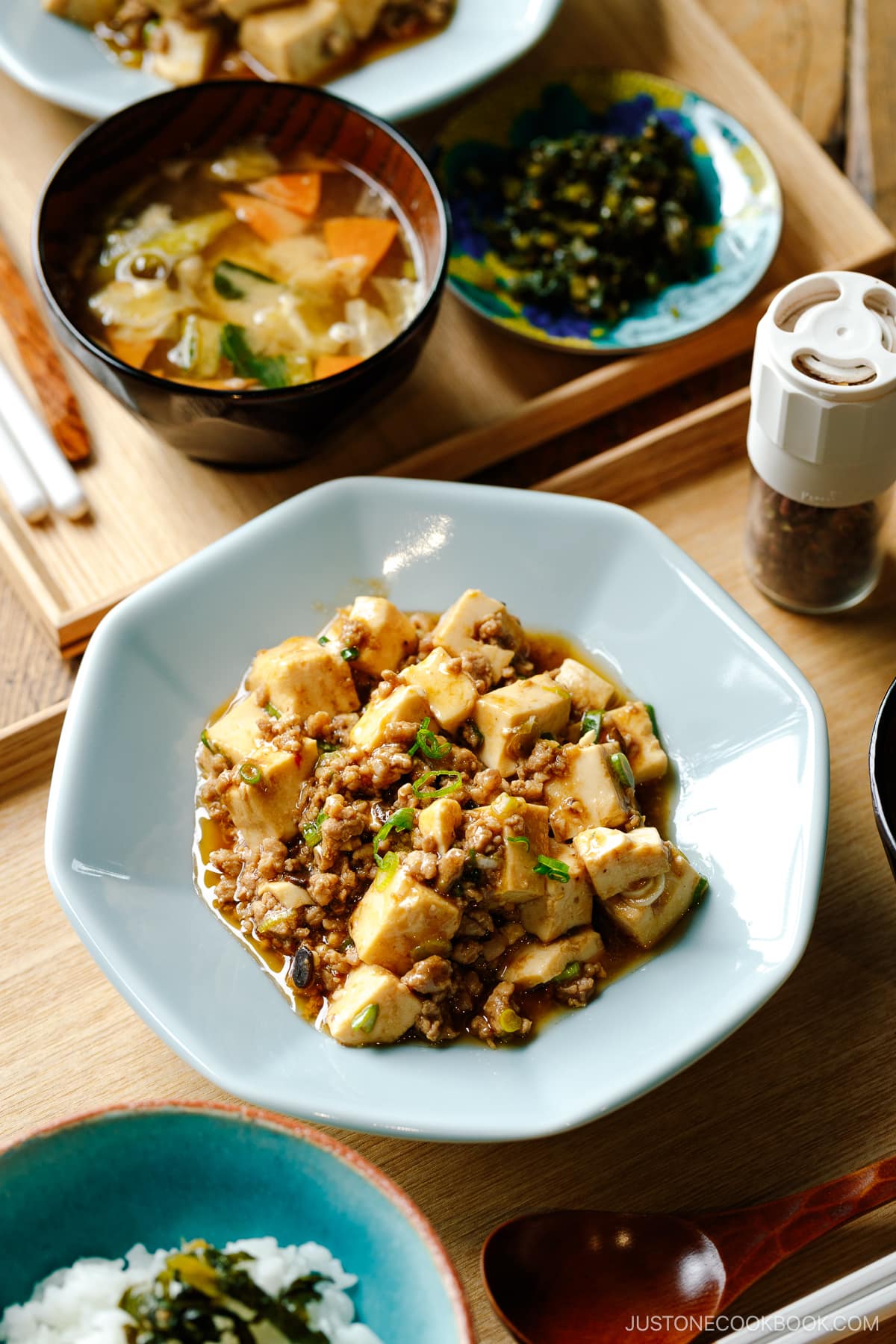
FAQs
Q: Can I use this recipe to make vegan or vegetarian mapo tofu?
Yes! Use finely diced shiitake mushrooms in place of the ground pork. Both fresh and dried mushrooms would work. Aldo, use vegetarian stir-fry sauce.
Q: Can I use another kind of ground meat instead of pork?
Sure, you can use ground chicken or turkey. Ground beef will have a stronger flavor, but it should be fine.
Q: Can I adjust the spice level?
You can cut down on doubanjiang (spicy bean paste) or use the Taiwanese non-spicy doubanjiang I mentioned earlier. If you like it slightly spicier, sprinkle la-yu (Japanese chili oil).
More Delicious Tofu Recipes
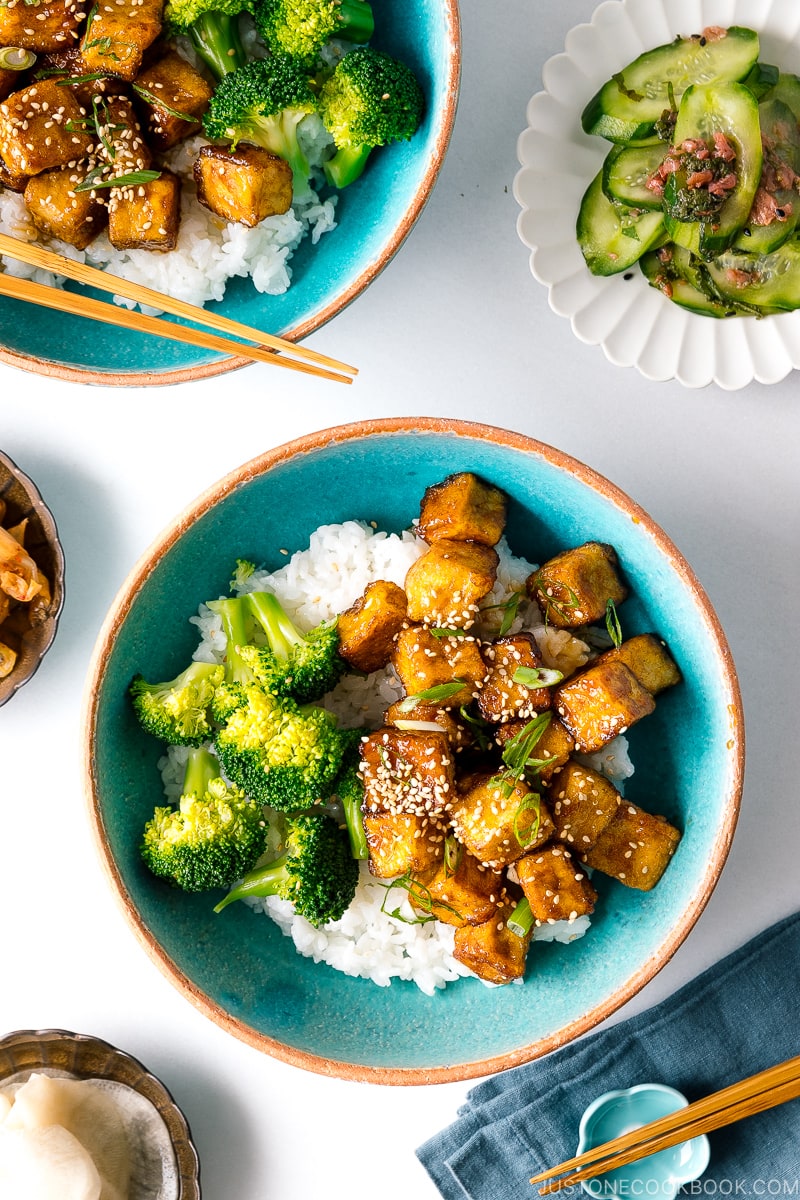
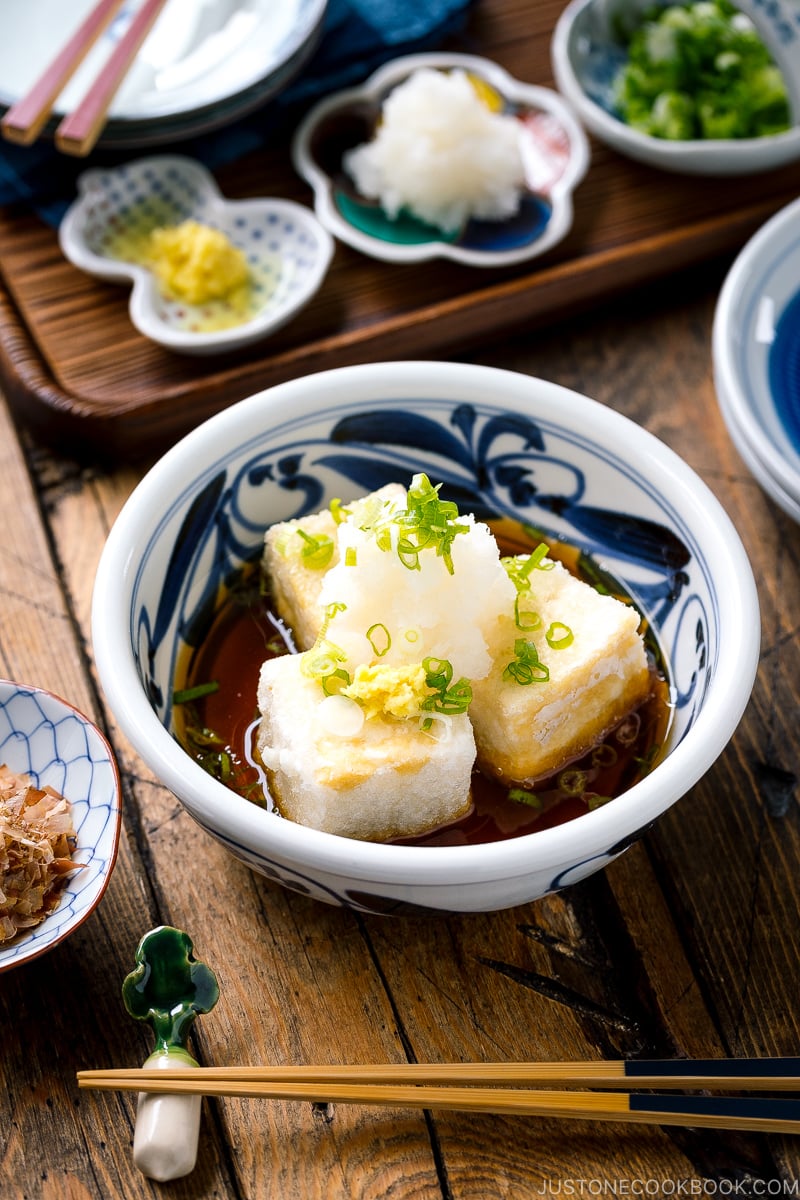
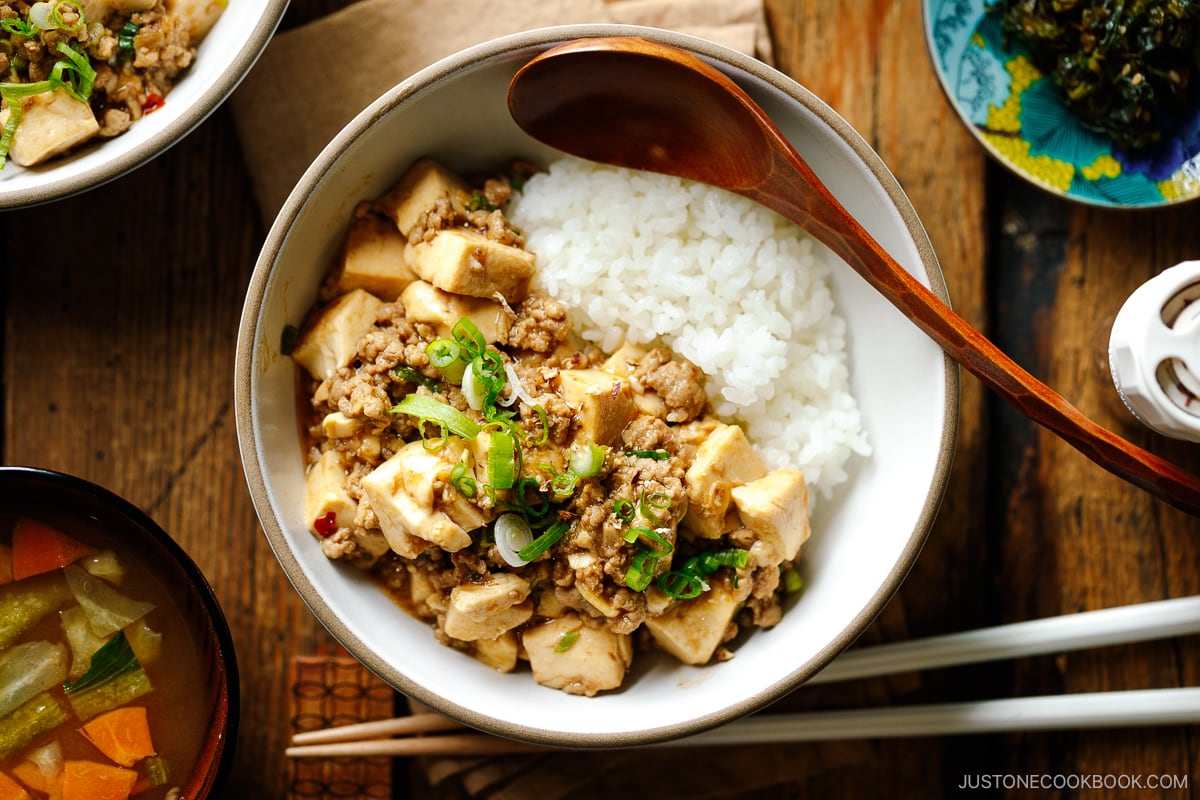
Wish to learn more about Japanese cooking? Sign up for our free newsletter to receive cooking tips & recipe updates! And stay in touch with me on Facebook, Pinterest, YouTubeand Instagram.
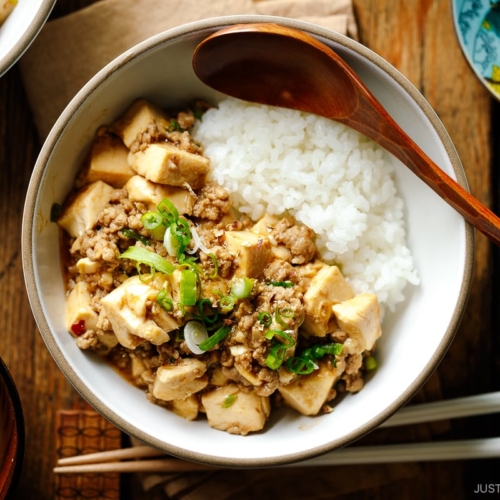
Mapo Tofu
Japanese-style Mapo Tofu (Mabo Dofu) is incredibly flavorful but a lot less spicy than the original Sichuan dish. This is a family-friendly recipe that children will enjoy, too. It‘s a delicious yet simple weeknight meal that‘s ready in just 30 minutes!
Ingredients
Prevent your screen from going dark
Instructions
-
Gather all the ingredients.
-
Combine all the seasonings. Add 2½ Tbsp doubanjiang (spicy chili bean paste), 1 Tbsp oyster sauce, 1 Tbsp miso, ½ Tbsp soy sauce, 2 Tbsp mirin, 1 tsp toasted sesame oil, 1 tsp potato starch or cornstarchand 4 Tbsp water in a bowl. Mix well together with a whisk.
-
Finely mince 2 cloves garlic (I use this garlic press). Peel the ginger skin thinly with a sharp knife. If you can’t peel it thinly, you can scrape it off with a spoon.
-
Cut the ginger into thin slices, julienne into thin strips, and then mince them. Measure 1 Tbsp ginger.
-
Cut 2 green onions/scallions into small pieces.
-
Drain 14 oz soft/silken tofu (kinugoshi dofu) and cut into ¾-inch (2 cm) cubes.
To Cook the Mapo Tofu
-
Heat a wok or large frying pan on medium heat. When it‘s hot, add 1 Tbsp neutral oil. When the oil is hot, add the garlic and ginger to the wok.
-
Sauté in the oil (make sure they don‘t burn). Once they are fragrant, add ½ lb ground pork.
-
Cook the pork, breaking up big chunks with a spatula or wooden spoon, until no longer pink.
-
Add the seasoning mixture and stir thoroughly. Bring the sauce to a simmer.
-
Once the sauce is simmering, add the tofu and gently coat it with the sauce. Stir frequently, without mashing the tofu, until it is heated through.
-
Add the green onions and stir to incorporate just before taking the pan off the heat.
Nutrition
Nutrition Facts
Mapo Tofu
Amount per Serving
% Daily Value*
* Percent Daily Values are based on a 2000 calorie diet.
©JustOneCookbook.com Content and photographs are copyright protected. Sharing of this recipe is both encouraged and appreciated. Copying and/or pasting full recipes to any website or social media is strictly prohibited. Please view my photo use policy here.
Editor’s Note: The post was originally published on January 29, 2011. The video and new pictures were added to the post on May 6, 2016, without any change to the recipe. The post has been republished with more content on May 25, 2022.

